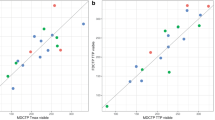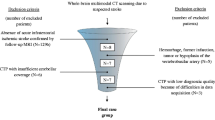Abstract
A comparative interim analysis was performed of clinical parameters, computed tomographic (CT) scan results and technetium-99m hexamethylpropylene amine oxime single-photon emission tomography (SPET) findings obtained within 12 h of acute supratentorial ischaemic infarction. First, the applicability for SPET semiquantification in this study of the “method of Mountz”, simultaneously accounting for extent and degrees of hypoperfusion by expressing deficits as millilitre of zero perfusion, was considered. Next, the relative contributions of perfusion SPET and CT scan in the acute stage of ischaemic infarction were compared in 27 patients (mean age 68.8 years). Finally, the correlation of SPET lesions with clinical parameters at onset was evaluated. The method of Mountz represents a workable, accurate virtual parameter, with the assumption that the contralateral brain region remains uninvolved. Interobserver reproducibility in 12 SPET studies, with lesions varying between 6 and 369 cc, showed a correlation coefficentr of 0.99. In practice, because of inconstant distribution of activities in the brain, the method can only be applied slice by slice and not on the total global volume. While the mean delay since the onset of symptomatology was approximately 7 h for both SPET and CT scan, SPET showed lesions concordant with the clinical neurological findings in 100% and CT scan in only 48%. One could hypothesize that SPET examinations performed later would show larger functional defects, because of the development of additional functional changes secondary to biochemical alterations. However, in this regard no statistically significant differences were found between two subproups, taking the median of delay before SPET examination as cut-off. Finally, when comparing the volumes of SPET lesions during the acute stage with clinical parameters, a statistically significant correlation (P<0.01) was found with the Orgogozo Scale scores describing the neurological deficit, but not with the Glasgow Coma Scale or Frenchay Aphasia Screening Test scores obtained on admittance.
Similar content being viewed by others
References
Reba RC, Holman BL. Brain perfusion radiotracers. In: Diksic M, Reba RC, eds.Radiopharmaceuticals and brain pathology studied with PET and SPELT. Boston: CRC Press; 1991: 35–39.
Lequin MH, Blok D, Pauwels EKJ. Radiopharmaceuticals for functional brain imaging with SPELT. In: Freeman LM, ed.Nuclear medicine annual. New York: Raven Press; 1991: 37–65.
Neirinckx RD, Canning LR, Piper IM, Nowotnik DP, Pickett RD, Holmes RA, Volkert WA, Forster AM, Weisner PS, Mariott JA, Chaplin SB. Technetium-99md,l-HMPAO: a new radiopharmaceutical for SPECT imaging of regional cerebral blood perfusion.J Nucl Med 1987; 28: 191–202.
Hoffman TJ, McKenzie EH, Volkert WA, Laughlin MH, Holmes RA. Validation of Tc-99m d, l-hexamethylpropylene amine oxime (Tc-99md,l-HMPAO) as a regional blood flow agent: a microsphere study.J Nucl Med 1986; 27: 1050.
Costa DC, Jones BE, Steiner TJ. Relative Tc-99m HMPAO and Sn-113 microsphere distribution in dog brain.Nuklearmedizin 1986; 25: A53.
Hartmann A. Prolonged disturbances of regional cerebral blood flow in transient ischaemic attacks.Stroke 1985; 16: 932–939.
Crols R, Moens E, Dierckx RA, Saerens J, De Deyn PP. Transient ischaemic attacks associated with amfepramone therapy.Funct Neurol 1993; 8: 351–354.
Sakai F, Ishii K, Igarashi H, Suzuki S, Kitai N, Kanda T, Tazaki Y. Regional cerebral blood flow during an attack of vertebrobasilar insufficiency.Stroke 1988; 19: 1426–1430.
Bose A, Pacia SV, Fayad P, Smith EO, Brass LM, Hoffer P. Cerebral blood flow (CBF) imaging compared to CT scan during the initial 24 hours of cerebral infaction.Neurology 1990; 40 Suppl 1: 190.
Giubilei F, Lenzi GL, Di Pipeo V, Pozzilli C, Pantano P, Bastianello S, Argentino C, Fieschi C. Predictive value of brain perfusion single-photon emission computed tomography in acute ischemic stroke.Stroke 1990; 21: 895–900.
Limburg M, van Royen EA, Hijdra A, de Bruine JF, Verbeeten B Jr. Single-photon emission computed tomography and early death in acute ischemic stroke.Stroke 1990; 21: 1150–1155.
Limburg M, van Royen EA, Hijdra A, Verbeeten B Jr. rCBF-SPECT in brain infarction: when does it predict outcome?J Nucl Med 1991; 32: 382–387.
Hanson SK, Grotta JC, Rhoades H, Tran HD, Lamki LM, Barron BJ, Taylor WJ. Value of single photon emission computerized tomography in acute stroke therapeutic trials.Stroke 1993; 24: 1322–1329.
Platt D, Horn J, Summa J-D, Schmitt-Rüth R, Reinlein B, Kauntz J, Kroenert E. Zur Wirksamkeit von Piracetam bei geriatrischen Patienten mit akuter zerebraler Ischämie. Eine klinisch kontrollierte Doppelblindstudie.Medwelt 1992; 43: 1–10.
Hederschěe D, Limburg M, van Royen EA, Hijdra A, Bueller HR, Koster PA. Thrombolysis with recombinant tissue plasminogen activator in acute ischaemic stroke: evaluation with rCBF-SPECT.Acta Neurol Scand 1991; 83: 317–322.
Shimosegawa E, Hatazawa J, Inugami A, Fujita H, Ogawa T, Aizawa Y, Kanno I, Okudera T, Uemura K. Cerebral infarction within six hours of onset: prediction of completed infarction with technetium-99m HMPAO SPECT.J Nucl Med 1994; 35: 1097–1103.
Orgogozo J-M, Dartigues JF. Clinical trials in brain infarction. In: Battistini N, Fiorani P, Courbier R, Plum F, Fieschi C, eds.Acute brain ischemia medical and surgical therapy. Serono Symposia Publications. New York: Raven Press; 1986; 32: 201–208.
Teasdale G, Jennet B. Assessment of coma and impaired consciousness: a practical scale.Lancet 1974; II: 81–83.
Enderby PM, Wood VA, Wade DT, Hewer RL. The Frenchay Aphasia Screening Test: a short, simple test for aphasia appropriate for non-specialists.Int Rehabil Med 1987; 8: 166–170.
Mountz JM, Modell JG, Foster NL, DuPree ES, Ackerman RJ, Petry NA, Bluemlein LE, Kuhl DE. Prognostication of recovery following stroke using the comparison of CT and technetium-99m HMPAO SPECT.J Nucl Med 1990; 3: 61–66.
Dierckx RA, Vandewoude M, Saerens J, Hartoko T, Mariën P, Capiau I, Vervaet A, Dobbeleir A, De Deyn PP. Sensitivity and specificity of single-headed Tc-99m HMPAO SPECT in dementia.Nucl Med Commun 1993; 14: 792–797.
Mountz JM. A method of analysis of SPECT blood flow image data for comparison with computed tomography.Clin Nucl Med 1989; 14: 192–196.
Mountz JM. Quantification of the SPEcT brain scan. In: Freeman LM, ed.Nuclear medicine annual. New York: Raven Press; 1991: 67–98.
Feeney DM, Baron JC. Diaschisis.Stroke 1986; 17: 817–830.
Andrews RJ. Transhemispheric diaschisis. A review and comment.Stroke 1991; 22: 943–949.
Lagreze HL, Levine RL, Sunderland JS, Nickles RJ. Pitfalls of regional cerebral blood flow analysis in cerebrovascular disease.Clin Nucl Med 1988; 13: 197–201.
Matsuda H, Tsuji S, Shuke N, Sumiya H, Tonami N, Hisada K. A quantitative approach to technetium-99m hexamethylpropylene amine oxime.Eur J Nucl Med 1992; 19: 195–200.
Dobbeleir A, Dierckx RA. Quantification of technetium-99m hexamethylpropylene amine oxime brain uptake in routine clinical practice using calibrated point sources as an external standard: phantom and human studies.Eur J Nucl Med 1993; 20:684–689.
Dierckx RA, Dobbeleir A, Maes M, Pickut BA, Vervaet A, De Deyn PP. Parameters influencing SPECT regional brain uptake of Tc-99m HMPAO measured by calibrated point sources as external standard.Eur J Nucl Med 1994; 21: 514–520.
Fieschi C, Argentino C, Lenzi GL, Sacchetti ML, Toni D, Bozzao L. Clinical and instrumental evaluation of patients with ischemic stroke within the first six hours.J Neurol Sci 1989; 91: 311–322.
De Roo M, Mortelmans L, Devos P, Verbruggen A, Wilms G, Carton H, Wils V, Van Den Bergh R. Clinical experience with Tc-99m HMPAO high-resolution SPECT of the brain in patients with cerebrovascular accidents.Eur J Nucl Med 1989; 15: 9–15.
Yamauchi H, Fukuyama H, Yamaguchi S, Doi T, Ogawa M, Ouchi Y, Kimura J, Sadatoh N, Yonekura Y, Tamaki N, Konishi J. Crossed cerebellar hypoperfusion in unilateral major cerebral artery occlusive disorders.J Nucl Med 1992; 33: 1632–1636.
Author information
Authors and Affiliations
Rights and permissions
About this article
Cite this article
Dierckx, R.A., Dobbeleir, A., Pickut, B.A. et al. Technetium-99m HMPAO SPET in acute supratentorial ischaemic infarction, expressing deficits as millilitre of zero perfusion. Eur J Nucl Med 22, 427–433 (1995). https://doi.org/10.1007/BF00839057
Received:
Revised:
Issue Date:
DOI: https://doi.org/10.1007/BF00839057




